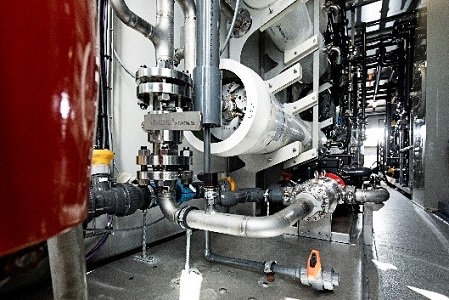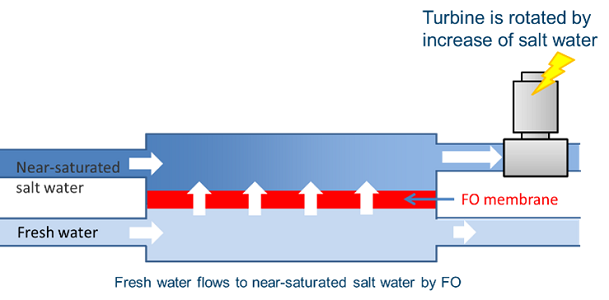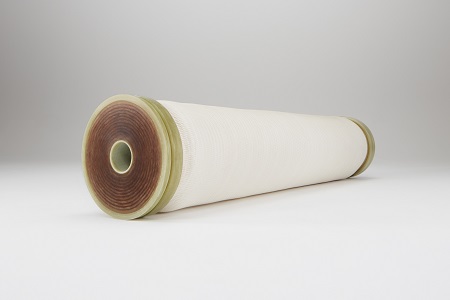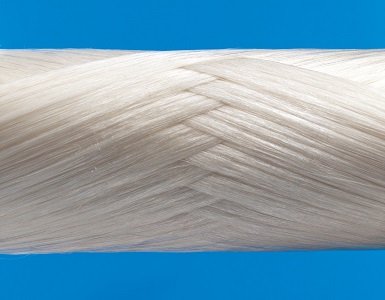Toyobo’s hollow-fiber FO membrane used at world’s first*1 osmotic power plant to help bring next-generation renewable energy system into practical use
Hollow-fiber forward osmosis (FO) membranes manufactured by Toyobo Co., Ltd. are being used for the world’s first fully functioning osmotic power plant*1 by Danish venture firm SaltPower. The plant is located at Nobians saltworks in Mariager, Denmark. It is scheduled to start operations in April 2023.

Osmotic power plant

Mechanism of osmotic power generation
Osmotic power generation uses the osmotic pressure difference between two types of solutions, such as fresh water and salt water, to generate electricity. The system can stably operate regardless of weather, day or night, and can generate power almost at the same cost as solar and wind power generation. For these reasons, it is attracting attention as a next-generation renewable energy power generation system, especially in Europe with its abundant natural resources such as underground rock salt layers and geothermal water.
The osmotic power generation plant developed by SaltPower generates about 100kW of power by utilizing the difference in salinity between salt water of almost saturated concentration that is pumped up for use in saltworks from underground rock salt layers*2 and fresh water.
Toyobo’s FO membrane allows water molecules but not molecules or ions above a certain size, such as those for the sodium chloride (salt) compound. So, when high concentration salt water and fresh water come into contact with each other across Toyobo’s FO membrane, their osmotic pressure difference causes water to flow to the salt water side, where the flow rate increases. This increase in flow rate is used to turn a turbine, which generates electricity.

Hollow fiber forward osmosis (FO) membrane

Cross winding structure
Toyobo’s FO membrane is semipermeable, with a cylindrical pressure vessel densely filled with hollow fibers. Thanks to its unique internal structure, which includes cross winding, both high concentration salt water and fresh water flow uniformly inside the FO membrane, and the increase in flow rate resulting from their osmotic pressure difference can be converted into highly efficient power generation.
Toyobo’s FO membrane for osmotic power generation also has excellent pressure resistance achieved by the technology that Toyobo has developed for manufacturing RO membranes for seawater desalination. This means the FO membrane can operate even under high operating pressure required for highly efficient osmotic power generation and maintain high power generation efficiency. Toyobo’s FO membrane has been used in an osmotic power generation pilot plant operated by SaltPower. The pilot plant went through many demonstration tests before going into practical use.
SaltPower plans to actively promote osmotic power plants using Toyobo’s FO membranes in Europe. Saltwork with solution mining and chlor alkali industry can benefit immediately from the technology. SaltPower also expect that osmotic power will contribute significantly to the green transition by generating energy when building salt caverns for seasonal storage for hydrogen.
In collaboration with SaltPower, Toyobo will continue to support the spread of osmotic power generation, which is one of the most promising renewable energy sources of the future. Toyobo will also contribute to solving environmental issues around the world by using its unique hollow fiber membrane technology for desalination plants that operate at low cost and with lower environmental impact, concentration of industrial wastewater and other factors.
■ Toyobo’s semipermeable membrane business
In the 1970s Toyobo developed a hollow-fiber semipermeable membrane which permeates water molecules, but not molecules and ions above a certain size, by applying a spinning technology Toyobo had developed in its textile production business. Toyobo has been supplying the product to desalination plants for many years as a reverse osmosis (RO) membrane for converting seawater into freshwater. At present, the hollow fiber RO membranes manufactured by the Toyobo Group produce about 1.6 million tons of fresh water per day, which is equivalent to water used by about 6.4 million people.
| ※1: | The world’s first practical application on a commercial scale, as of February 16, 2022, based on Toyobo data. |
| ※2: | In saltworks, salt water near saturated concentration water is pumped from underground rock salt layers for producing salt after water is fed from above ground into the salt layers through hydraulic pumps. |
For more information, contact
Public Relations Group, Corporate Communication Department, Toyobo Co., Ltd.
MAILpr_g@toyobo.jp
Cautionary Statement
This website contains forward-looking statements that reflect Toyobo's plans and expectations. These forward-looking statements are not guarantees of future performance and involve known and unknown risks, uncertainties and other factors that may cause Toyobo's actual results, performance, achievements or financial position to be materially different from any future results, performance, achievements or financial position expressed or implied by these forward-looking statements.






